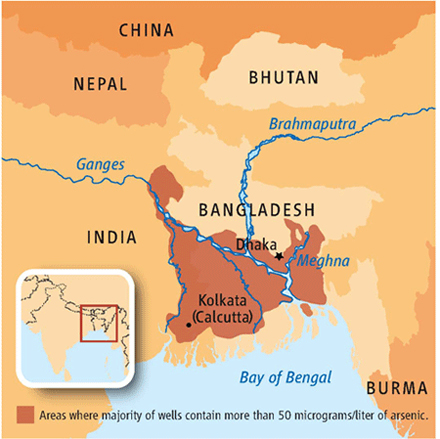MIT tries to solve history’s ‘largest mass poisoning’
 |
|
Areas of Bangladesh and West Bengal (India) where there is mass incidence of arsenic into well water Source: Bhattacharjee, 2007. "A Sluggish Response to Humanity's Biggest Mass Poisoning." Science |
Researchers in MIT’s Department of Civil and Environmental Engineering believe they have pinpointed a pathway by which arsenic may be contaminating the drinking water in Bangladesh, a phenomenon that has puzzled scientists, world health agencies and the Bangladeshi government for nearly 30 years.
Bangladesh, one of the most crowded nations, is the seventh most populous country in the world, and tens of millions of its citizens have been exposed to arsenic in their water over the past several decades. As many as 3,000 Bangladeshis die from arsenic-induced cancer each year and today approximately 2 million people in the country live with arsenic poisoning, which manifests as skin lesions and neurological disorders, and causes cardiovascular and pulmonary diseases and cancer. Indeed the WHO released a report in September estimating that between 35 and 77 million Bangladeshis may be drinking water containing more than the safety limit of 10 parts per billion of arsenic.It also stated that 1 million Indians are also drinking arsenic water. According to the report’s author, Allan Smith of the University of California, Berkeley, the scale of the disaster is “beyond Bhopal; beyond Chernobyl,the largest mass poisoning of a population in history” .
Three decades ago health and development experts, and small local contractors, dug millions of deep tube wells throughout Bangladesh. The experts
encouraged the whole nation to drink well water because it was deemed to be safe, free of the bacteria that causes water-borne diseases such as
diarrhea and other intestinal maladies that have long plagued the tropical country.
But in switching from rivers and other surface sources of water, the people of Bangladesh may have exchanged water-borne diseases for slow poisoning
by arsenic. In the 1970's public health specialists and government policy-makers were unaware of the problem. It was only in 1993 that
"clean" well water was discovered to contain dangerous quantities of the poison. Scientists have struggled to understand how the arsenic,
which is naturally occurring in the underground sediment of the Ganges Delta, is getting into the groundwater.
Arsenic-contaminated water is not restricted to developing countries. In the western states of the United States of America about 13 million people
drink arsenic-tainted water, albeit less contaminated than the well water in Bangladesh. Australia, too, has arsenic-contaminated water. So do
Argentina, Brazil, Chile, Hungary, Mexico, Taiwan (Province of China), Thailand, Vietnam, and the eastern areas of India in Bengal.
Arsenic poisoning is recognizable from skin color changes, blotches all over the face and body, hyper pigmentation on the chest and upper arms, hard
patches on palms and soles of the feet, inability to walk, debilitating pain, and watery eyes.
By 2002, a research team led by Charles Harvey, the Doherty Associate Professor of Civil and Environmental Engineering at MIT, had determined that
microbial metabolism of organic carbon was mobilizing the arsenic off the soils and sediments, and that crop irrigation was almost certainly playing a
role in the process. But the exact sources of the contaminated water have remained elusive, until now.
The research(a paper that appeared online in Nature Geoscience Nov. 15) by students of MIT suggests that human alteration to the landscape, the construction of villages with ponds, and the adoption of irrigated agriculture are responsible for the current pattern of arsenic concentration underground. The findings also indicate that drinking-water wells drilled to a greater depth would likely provide clean water. The authors explain that ponds are the source of the organic carbon that presently mobilizes the arsenic in their 6-square-mile test site. The carbon settles to the bottom of the ponds, then seeps underground where microbes metabolize it. This creates the chemical conditions that cause arsenic to dissolve off the sediments and soils and into the groundwater.
“Our research shows that water from the ponds carries degradable organic carbon into the shallow aquifer. Groundwater flow, drawn by irrigation pumping, transports that pond water to the depth where dissolved arsenic concentrations are greatest and where it is then pumped up into the irrigation and drinking wells,” says Harvey, whose research was funded by the National Science Foundation and the Singapore-MIT Alliance for Research and Technology. “The other interesting thing we found in our test area is that the rice fields are a sink of arsenic — more arsenic goes in with the irrigation water than comes out in the groundwater.”
The solution can be by using surface water and instituting effective withdrawal regulation. West Bengal and Bangladesh are flooded with surface
water. We should first regulate proper watershed management. Treat and use available surface water, rain-water and others. The researchers suggest
that the problem could be alleviated by digging deeper drinking water wells below the influence of the ponds or by locating shallow drinking wells
under rice fields.
